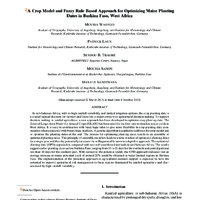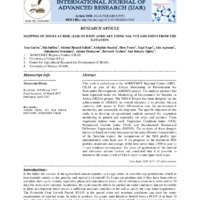Recherche
4 items
A Crop Model and Fuzzy Rule Based Approach for Optimizing Maize Planting Dates in Burkina Faso, West Africa
In sub-Saharan Africa, with its high rainfall variability and limited irrigation options, the crop planting date is a crucial tactical decision for farmers and therefore a major concern in agricultural decision making.
Ensuring peaceful livestock mobility
Mobile livestock production in the Sahel and West Africa is a way of life and a form of adaptation and resilience developed over thousands of years by pastoralists and agro-pastoralists to cope with the effects of desertification and climate change, and to make the best use of the vast expanses of arid and semi-arid regions. This livestock farming system makes it possible to seek complementarities with the agro-ecological zones of the southern savannah regions through the use of pasture and water. In this way, livestock farming helps to provide substantial income for the local population and ensure food security. The N’Djamena symposium in the Republic of Chad (May 2013) and the Nouakchott declaration in the Islamic Republic of Mauritania (October 2013) gave renewed interest to the livestock sector with the implementation of several regional initiatives such as PRAPS, PREDIP, PEPISAO financed respectively by the World Bank, the European Union and the Agence Française de Développement and coordinated by CILSS as well as others such as PACBAO, MOPSS, etc.
Mapping of Zones At Risk (ZAR) in west Africa by using NGI, VCI and SNDVI from the E-statuib
This work is carried out at the AGRHYMET Regional Centre (ARC)-CILSS as part of the African Monitoring of Environment for Sustainable Development (AMESD) project. The analysis protocol has been improved under the Monitoring of Environment for Security in Africa (MESA) project. The MESA Project has been designed on the achievements of AMESD; its overall objective is to provide African countries with access to Earth Observation data for environmental monitoring and sustainable development. The specific objective of this study is to develop an operational analysis protocol for vegetation monitoring in general and especially for crops and pastures. Three vegetation indices were used: Vegetation Condition Index (VCI), Normalized Growth Index (NGI) and Standardized Normalized Difference Vegetation Index (SNDVI). The analysis of these drought indices is based on taking into account the agro-climatic characteristics of the Sahelian region, the comparison of the NGI profile (per administrative unit) from year X (in progress) to the maximum NGI profiles, minimum and average of the time series data (1998 to year x-1) and evidence convergence. Six years of application of the method and validation actions carried out concluded that it is possible to determine the zones at risk (ZAR) in order to anticipate food crises.
Products for capitalizing on experiences and acquired knowledge of PREDIP
CILSS has achieved significant results and a great deal of experience through the PREDIP implementation. A sample of eleven (11) major experiments and lessons learnt have been drawn up and documented using the “ongoing capitalisation» approach, with a view to building on these achievements for the benefit of stakeholders in the livestock and pastoralism sub-sector in the Sahel and West Africa. The experiments cover all the themes addressed by PREDIP (i.e., regional pastoral information service, dialogue and governance on cross-border transhumance, agro-pastoral infrastructures and facilities, animal health). Each of the fact sheets documenting these experiments includes a short summary giving the reader an overview of the content of the experiment and enabling him or her to extract the information he or she needs. In addition to these eleven (11) sheets, two (2) capitalisation notes have been produced. These experiments and capitalisation notes can be scaled up for greater value. They complement the existing body of knowledge on the promotion of the livestock sub-sector. For more detailed information, the reader is kindly invited to read the full report entitled: «Experience gained and lessons learnt from PREDIP implementation».


